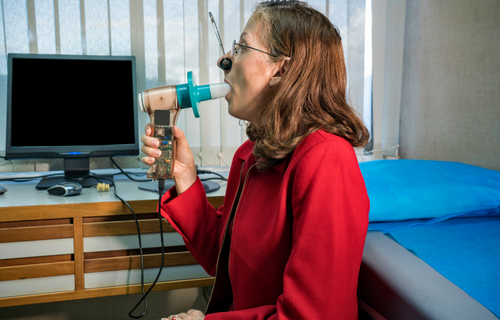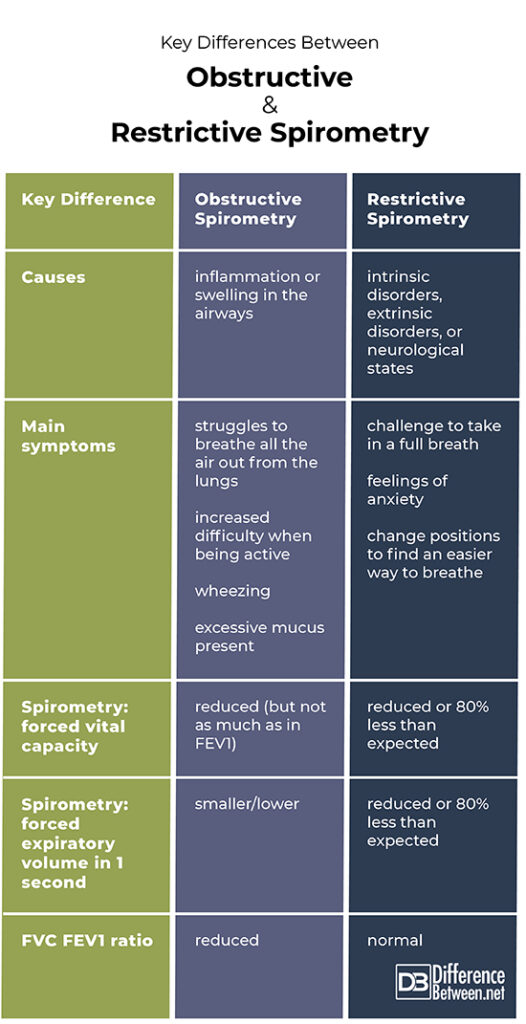Difference Between Obstructive and Restrictive Spirometry

Introduction
Spirometry is a medical diagnostic tool that is used to find, monitor and manage patients diagnosed with a variety of lung diseases or disorders which can be obstructive or restrictive.
Restrictive lung disease results in trouble breathing in air, where obstructive lung disease sees patients with trouble breathing air out.
Both types of lung disease are diagnosed with spirometry, however they appear differently when the results come up.
This article will look at what each are, their causes, treatments and take a closer look at their key differences.

Definitions
Obstructive Lung Disease
Obstructive lung disease refers to a presentation whereby a person’s air passages become obstructive, and exhalation becomes slowed down and shallow in nature.
Restrictive Lung Disease
Restrictive lung disease is commonly defined as a state where a person has difficulty to fill their lungs with air and there is a totally reduced lung capacity.
Causes and Disorders
Obstructive Lung Disease
This condition is most often caused by inflammation or swelling in the airways.
The associated disorders include chronic bronchitis, asthma, cystic fibrosis, chronic obstructive pulmonary disease, and bronchiolitis.
Restrictive Lung Disease
This condition can be caused by intrinsic disorders, extrinsic disorders, or neurological states.
The associated disorders include pneumonia, tuberculosis, sarcoidosis, pulmonary fibrosis and types of lung surgery (intrinsic); excessive weight, broken ribs, pleural effusion, growing tumors, and scoliosis (extrinsic); or Guillain-Barre Syndrome, muscular dystrophy, and a paralysed diaphragm (neurological).
Symptoms and Spirometry
Obstructive Lung Disease
Typically, a patient suffering with obstructive lung disease struggles to breathe all the air out from the lungs and feels increased difficulty when being active. There is often also wheezing and excessive mucus present.
When it comes to spirometry testing, obstructive lung disease presents as the following:
- Forced vital capacity (inhale as far as possible and forced exhale): reduced (but not as much as in FEV1)
- Forced expiratory volume in 1 second (measure of exhaled air): smaller/lower
- FVC FEV1 ratio (how much air can be exhaled in 1 second vs. normally): reduced
Restrictive Lung Disease
In most cases, a patient suffering from restrictive lung disease feels like it is a challenge to take in a full breath which often also causes feelings of anxiety. Patients typically try change positions as much as possible to find an easier way to breathe.
When it comes to spirometry testing, restrictive lung disease presents as the following:
- Forced vital capacity (inhale as far as possible and forced exhale): reduced or 80% less than expected
- Forced expiratory volume in 1 second (measure of exhaled air): reduced or 80% less than expected
- FVC FEV1 ratio (how much air can be exhaled in 1 second vs. normally): normal
Key Differences Between Obstructive and Restrictive Spirometry

Summary
Obstructive lung disease is usually a result of inflammation or swelling of the airway.
In spirometry it usually presents with a reduced forced vital capacity (inhale as far as possible and forced exhale), smaller/lower forced expiratory volume in 1 second (measure of exhaled air), and a reduced FVC FEV1 ratio (how much air can be exhaled in 1 second vs. normally).
Restrictive lung disease is usually caused by intrinsic, extrinsic or neurological disorders.
In spirometry it usually presents with a reduced or 80% less than expected forced vital capacity (inhale as far as possible and forced exhale), reduced or 80% less than expected forced expiratory volume in 1 second (measure of exhaled air), and a normal FVC FEV1 ratio (how much air can be exhaled in 1 second vs. normally).
FAQ
What is obstructive spirometry?
Typically, a patient suffering with obstructive lung disease struggles to breathe all the air out from the lungs and feels increased difficulty when being active. There is often also wheezing and excessive mucus present.
When it comes to spirometry testing, obstructive lung disease presents as the following:
- Forced vital capacity (inhale as far as possible and forced exhale): reduced (but not as much as in FEV1)
- Forced expiratory volume in 1 second (measure of exhaled air): smaller/lower
- FVC FEV1 ratio (how much air can be exhaled in 1 second vs. normally): reduced
What is the difference between obstructive and restrictive diseases?
Obstructive lung disease refers to a presentation whereby a person’s air passages become obstructive, and exhalation becomes slowed down and shallow in nature. This condition is most often caused by inflammation or swelling in the airways.
The associated disorders include chronic bronchitis, asthma, cystic fibrosis, chronic obstructive pulmonary disease, and bronchiolitis
Restrictive lung disease is commonly defined as a state where a person has difficulty to fill their lungs with air and there is a totally reduced lung capacity. This condition can be caused by intrinsic disorders, extrinsic disorders, or neurological states.
The associated disorders include pneumonia, tuberculosis, sarcoidosis, pulmonary fibrosis and types of lung surgery (intrinsic); excessive weight, broken ribs, pleural effusion, growing tumors, and scoliosis (extrinsic); or Guillain-Barre Syndrome, muscular dystrophy, and a paralysed diaphragm (neurological).
What is a restrictive spirometry pattern?
When it comes to spirometry testing, restrictive lung disease presents as the following:
- Forced vital capacity (inhale as far as possible and forced exhale): reduced or 80% less than expected
- Forced expiratory volume in 1 second (measure of exhaled air): reduced or 80% less than expected
- FVC FEV1 ratio (how much air can be exhaled in 1 second vs. normally): normal
Is FEV1 restrictive or obstructive?
Forced expiratory volume in 1 second (measure of exhaled air) is smaller/lower in obstructive lung disease spirometry testing.
Forced expiratory volume in 1 second (measure of exhaled air) is reduced or 80% less than expected in restrictive lung disease spirometry testing.
- Difference Between a Cochlear Implant and Normal Hearing - October 4, 2022
- Difference Between Obstructive and Restrictive Spirometry - September 11, 2022
- The Difference Between White Box and Black Box Testing - September 11, 2022
Search DifferenceBetween.net :
Leave a Response
References :
[0]Asp, K. 2020. “Obstructive Lung Disease vs Restrictive Lung Disease: Causes, Diagnosis, and Treatment Options”. https://www.aastweb.org/blog/obstructive-lung-disease-vs-restrictive-lung-disease-causes-diagnosis-and-treatment-options
[1]Leader, D. “An Overview of Obstructive vs. Restrictive Lung Diseases”. https://www.verywellhealth.com/obstructive-and-restrictive-lung-diseases-914741
[2]Ranu, H., Wilde, M. & Madden, B. “Pulmonary Function Tests”. Ulster Medical Journal, vol. 80, no. 2, 2011, pp: 84-90.
